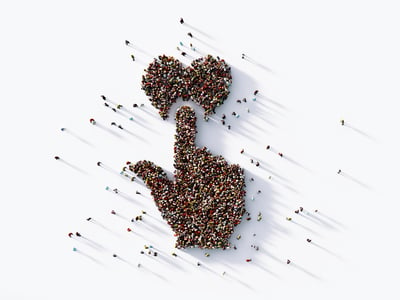.jpg)
Your nonprofit hosts some incredible events throughout the year. You plan and plan to make sure these events are entertaining and engage the right audiences.
The result of such hard work and extensive event planning is adding a slew of contact data into your donor database. From new donors to engaged supporters, successful fundraising events lead to more opportunities for outreach and stewardship.
Before you can use new data for your various nonprofit strategies, you first need to get everything organized.
That’s why we’ve compiled the top 10 strategies for organizing donors after your big fundraising event. This organization will help you segment these supporters and best reach out to them in the future.
The first segment you should assign from your list of event attendees is “new engagement.” These are the brand new supporters who have never engaged with your nonprofit before. The event was their introduction to your mission and activities.
With these brand new supporters, you should send them a “welcome” message or packet to provide more information about your organization and the type of work you do.
When your event registration information is streamlined into your CRM, you can easily create a segment for these supporters from the very beginning. Looking for a CRM solution with event registration and the ability to personalize this “welcome” message? Bloomerang’s nonprofit CRM guide will help you find the best solution for your nonprofit.
Many organizations host fundraising campaigns that run up until the start of the event itself. One meaningful segment you should assign is those who gave before the start of your event. An example of such a campaign is peer-to-peer fundraising.
Launching a peer-to-peer fundraising campaign leading up to the event is a great way to collect revenue while raising awareness to your supporter’s online networks.
You may also ask companies to help sponsor the event before it begins. Keep track of the connections supporters may have with these companies for the future.
Organize donors and companies who gave during these campaigns so that you can thank them for helping make the event possible. Try thanking these supporters during the event, especially those who may have sponsored the event with a hefty donation. Feature names of those who helped at an event booth or include sponsor names on merchandise as recognition.
While fundraising events serve many purposes for nonprofits, from stewardship to event marketing, the primary reason for hosting one is raising money. Be sure you create a list of those who donated to your organization for the very first time at the event.
First-time donors who were inspired by your awesome fundraising event have already kicked off their engagement in a strong way. Keep this engagement up!
If you’re able to convince a first-time donor to give again, the repeat donor retention rate skyrockets from around 20% to over 60%. Therefore, your retention rate is highly dependent on capturing these new supporters.
Invest in fundraising software focused on retention efforts so that you can reach out directly to this important segment. You may choose to set up a template for this segment, then use automation tools to thank them quickly and start stewarding donors for another gift.
If recruiting volunteers was one of the items on your nonprofit’s event planning checklist, you should be sure to create a “volunteer” segment in your CRM of your volunteers. It’s easy to think of donors in strictly financial terms, but volunteers have given their time to your nonprofit and you should recognize them for it. They are unsung heroes!
Be sure your nonprofit CRM stores information about volunteers in addition to traditional donors. This will help you identify overlap between the two groups.
Those who volunteer with charities are also much more likely to donate financially. Some studies even claim that they’re 10 times more likely to do so!
So whether you want them to volunteer at future events or give to your cause, you should reach out to this segment to thank them and tell them about upcoming opportunities to support your nonprofit.
Not everyone that attends your event will be brand new supporters of your mission. Actually, many of them will likely be supporters who have been engaged with your organization for quite some time.
The attendance of your regular donors gives you a chance to get creative in your outreach. You have the opportunity to thank these supporters every time they engage, so make it count every single time.
Stewarding supporters to become monthly donors is great, but too many nonprofits simply acquire these regular donors and then forget about them. This isn’t a good way to maintain monthly donors, so be sure to continue encouraging engagement.
When monthly donors attend an event, you’re already off to a great start. You have effectively engaged them past simply giving money. They want to stay involved with the organization. Send unique and appreciative messages to these donors to continue this engagement.
Events are a great opportunity to boost your nonprofit’s presence on social media. Many nonprofits will host competitions at events to boost social media activity, such as providing a prize for the first new Facebook follower or the first to use the event hashtag.
This is a great practice to get people initially involved with social media, especially considering that 63% of marketers in 2017 found social media to be an effective platform to build a loyal following.
While these people may not be donors just yet, your organization has opened up an opportunity to steward them to become donors in the future. Monitor your social media and respond to those who mention your nonprofit or event.
By segmenting supporters by those who are actively engaging with your organization on social media, your nonprofit gains a new and effective way of communicating with this audience.
After your event is over, consider sending out a survey to your attendees. Then, compile a segment of supporters who provided positive responses into a segmented list in your CRM.
Those who provide positive feedback to your survey should make up one category.
When people provide positive feedback about your nonprofit’s events, it’s a good indication towards them attending another event in the future. Plus, you get to see what elements of event planning are going well for your nonprofit.
If you invest in fundraising software that has a survey feature, you can streamline the process for creating segments of positive responders.
Tip: Is free fundraising software a good idea? Read more here!
Just as positive feedback is an indication as to what your nonprofit is doing well, negative feedback helps your nonprofit understand what you can improve upon at your next event.
As you write your survey questions, be careful not to lead the respondent to a positive answer. As hard as is to hear, negative feedback is good for your nonprofit. If you address negative aspects of your strategy, you’re more likely to expand your reach and appeal to more supporters.
Thank those who provide negative feedback on your survey. Group them into a segment in your CRM, and let them know that their voice was heard.
By addressing the concerns of those with negative feedback, you’ll improve the chances of them returning to your nonprofit. Don’t give up on them simply because they have something negative to say.
Consider the supporters who didn’t attend your recent event, but have attended others in the past. Are they in danger of becoming lapsed supporters? It’s impossible to achieve a 100% retention rate for donations or event attendance. However, you want to make sure it’s as high as possible.
For those who did not attend your event, but have attended your nonprofit’s events in the past, create a special segment in your donor database to help you reach out to them.
Take a proactive approach with these supporters. Let them know that your organization misses their support and invite them to the next event.
If you’ve gathered additional information from your supporters from the pre-event campaigns, registration, event donation, or survey processes that give you insight as to who their employer is, take note to create a segment of match-eligible supporters.
Some companies will match the donations given to nonprofits by their employees as a part of their corporate philanthropy programs. This helps your nonprofit maximize the impact of gifts that match-eligible supporters make.
About $4-$7 billion in matching gifts go unclaimed every year according to Double the Donation. This is because donors simply don’t know the option is available to them.
When you have a defined segment of gift-eligible supporters in your donor database, you can easily market this opportunity and boost your donations.
Your fundraising events will bring your supporters of all levels to the same location. Make sure you’re ready and organized as soon as possible after the event to continue the stewardship of your supporters. This will help keep the fundraising cycle moving and boost your donor retention rates.
Jay B. Love is a Co-Founder and current Chief Relationship Officer at Bloomerang.
He has served this sector for 33 years and is considered the most well-known senior statesman whose advice is sought constantly.
Prior to Bloomerang, he was the CEO and Co-Founder of eTapestry for 11 years, which at the time was the leading SaaS technology company serving the charity sector. Jay and his team grew the company to more than 10,000 nonprofit clients, charting a decade of record growth.
As a nonprofit professional, you know the value of developing genuine relationships with your...
 by Steven Shattuck
by Steven Shattuck
Nonprofit organizations don’t exist without consistent, generous support from their donors.
 by Brad Dowhaniuk
by Brad Dowhaniuk
Getting a donor is half the battle; the other half is keeping them.
 by Gerard Tonti
by Gerard Tonti
As a nonprofit professional, you know the value of developing genuine relationships with your...
 by Steven Shattuck
by Steven Shattuck
Nonprofit organizations don’t exist without consistent, generous support from their donors.
 by Brad Dowhaniuk
by Brad Dowhaniuk


